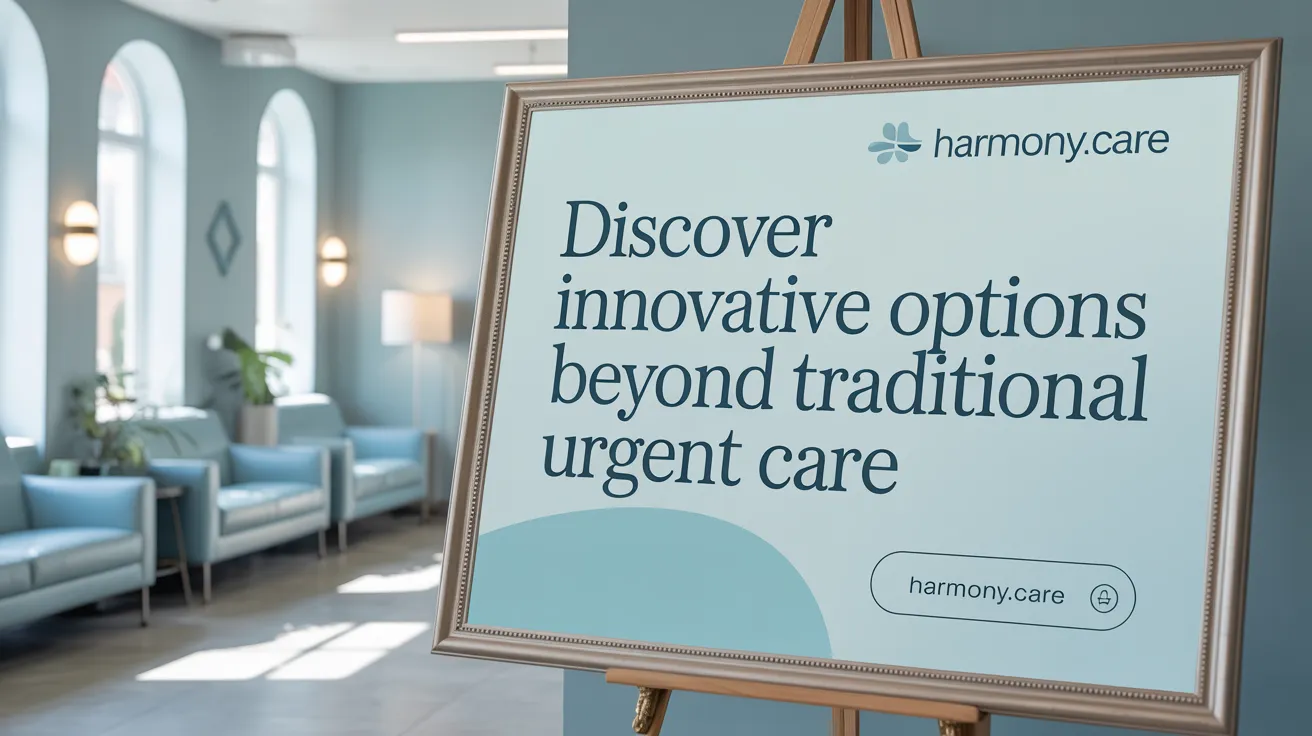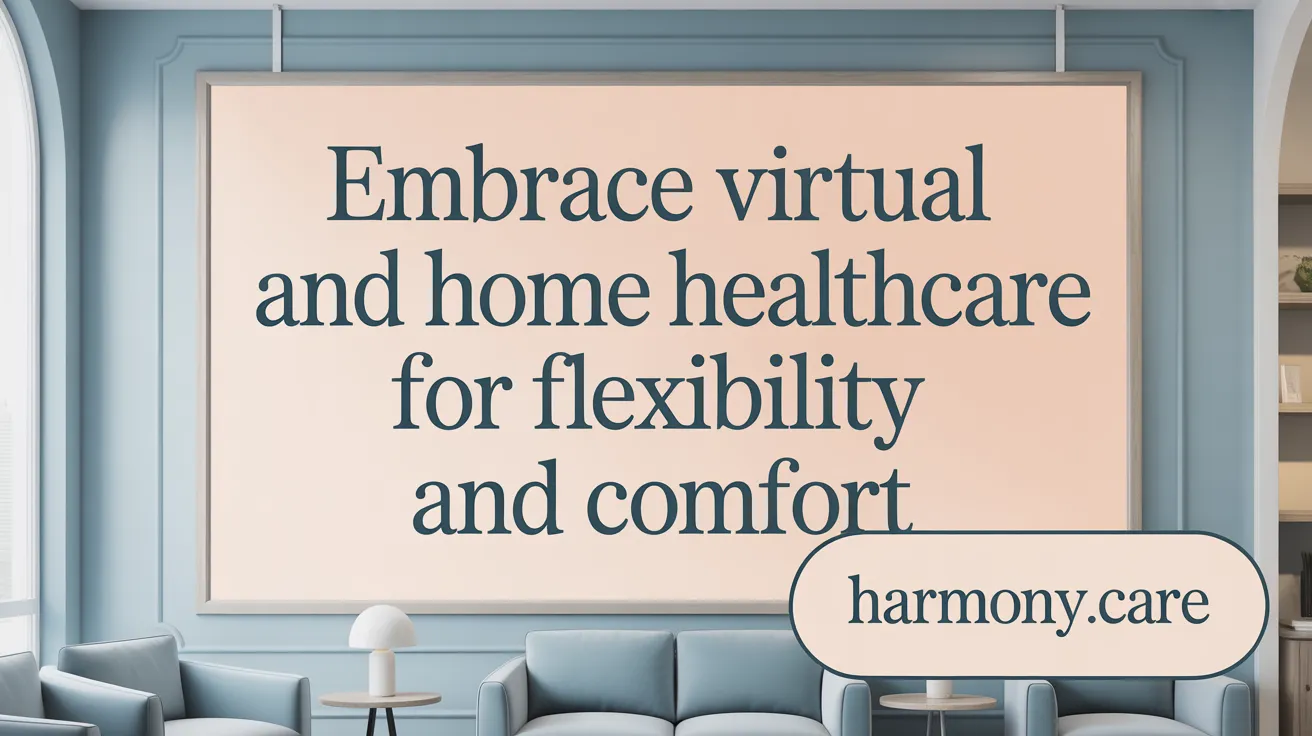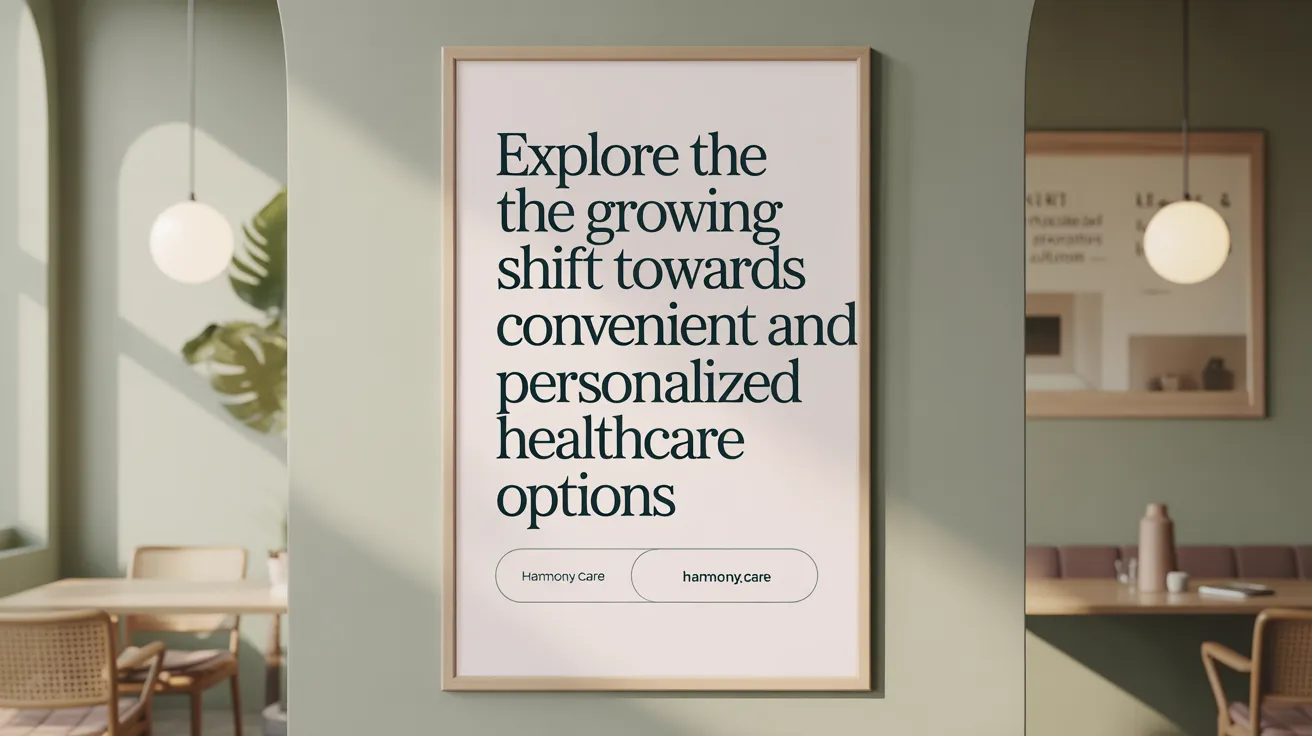Rethinking Urgent Care: Embracing Safety and Natural Health Alternatives
As healthcare evolves, many people are seeking alternatives to traditional urgent care services that prioritize safety, convenience, and natural healing principles. From virtual consultations and home-based care to holistic therapies and community clinics, these alternatives offer diverse options for non-emergency health needs. This article explores various natural and minimally invasive healthcare models, compares their safety and effectiveness to conventional urgent care, and offers guidance on integrating complementary medicine—especially for children. Whether for routine illnesses, minor injuries, or preventive care, understanding these evolving care options can empower patients to make informed and personalized healthcare decisions.
Diverse Alternatives to Conventional Urgent Care
 In recent years, many Americans are exploring different healthcare options beyond traditional emergency rooms and urgent care centers. These alternatives focus on convenience, holistic wellness, and personalized attention.
In recent years, many Americans are exploring different healthcare options beyond traditional emergency rooms and urgent care centers. These alternatives focus on convenience, holistic wellness, and personalized attention.
One notable trend includes on-demand house calls and virtual doctor visits. App-based services like Heal connect patients with physicians within hours, offering house calls and virtual consultations. Similarly, platforms like One Medical provide same- or next-day appointments and accessible virtual care, reducing the need for in-person visits.
Retail clinics, often located inside pharmacies or supermarkets, are an accessible quick-treatment option. They don’t require appointments and typically handle minor illnesses such as colds or skin conditions. Some retail clinics now expand their services to include wellness counseling, vaccination, and chronic disease management.
In addition, direct primary care practices charge a flat monthly fee for unlimited visits, bypassing insurance. These practices foster longer, more thorough appointments to better manage ongoing health issues like chronic conditions. For those seeking an even more personalized experience, concierge practices offer luxury healthcare with same-day appointments, quick communication, and access to top specialists, often at a higher cost.
Hybrid models are also gaining popularity. Combining virtual and in-person care, these solutions emphasize preventative health, genetic screening, and convenience. Many accept insurance, while others charge flat fees, appealing to diverse patient needs.
Beyond these, workplace clinics provide employees with easy access to basic health services and wellness programs, often covered by employer insurance. For individuals needing continued or home-based support, home primary care services use portable diagnostic tools and apps to deliver healthcare directly at home, especially benefiting those with mobility challenges.
Complementing these are urgent care facilities, which extend hours and offer diagnostic tools like X-rays and labs, reducing unnecessary ER visits. Walk-in clinics also provide prompt treatment without appointments for minor issues.
Telemedicine platforms have expanded access, allowing patients to have video, chat, or phone consultations with providers from home. This method helps reduce travel time and waiting periods, making healthcare more accessible.
Furthermore, community health centers and pediatric clinics deliver preventive, affordable care, especially targeting underserved populations. Nurse practitioner clinics and mobile health units also fill critical gaps by providing diagnosis, treatment, and health education.
Of particular interest are natural and holistic healthcare options. These include acupuncture, herbal medicine, chiropractic care, massage therapy, meditation, yoga, and energy therapies like Reiki. Such practices aim to promote overall wellness and mental health, often used alongside conventional medicine.
Research supports some approaches like acupuncture and mindfulness, yet others like homeopathy require more evidence. These natural therapies can be integrated into treatment plans to support mental and physical health.
In a changing healthcare landscape, these diverse options help improve access, reduce costs, and support holistic wellness, especially for those who may be hesitant about traditional urgent care or emergency services.
Virtual and Home-Based Care: Convenient and Patient-Centered

How do virtual health services and telemedicine enhance patient care?
Virtual health services and telemedicine have become increasingly popular by offering consultations via video calls, chats, or phone, making healthcare more accessible. Patients can receive medical advice, prescriptions, and follow-up care without leaving their homes. This approach reduces travel time, shortens wait periods, and allows for flexible scheduling.
What is home-based primary care and how does it work?
Home-based primary care is designed for individuals with mobility issues or those needing early detection of health concerns. It uses portable diagnostic equipment and smartphones to provide medical services directly at home. This model not only enhances comfort but also enables continuous monitoring of chronic conditions and early intervention.
How app-based services like Heal facilitate on-demand house calls?
Apps such as Heal connect patients with physicians within as little as two hours, offering house calls for non-emergency health issues. These services provide a convenient alternative to urgent care clinics, especially for minor ailments and follow-up visits. They often operate around the clock, fitting into busy schedules.
What are hybrid virtual/in-person care models?
Hybrid models combine virtual and in-person visits to tailor healthcare to individual needs. Some providers accept insurance, while others charge flat fees, focusing on preventive care, genetic testing, and chronic disease management. This flexibility allows patients to choose the most suitable method and reduces unnecessary emergency room visits.
Why are these models important for improving healthcare access?
These alternative care options expand healthcare reach, especially for underserved communities, by providing more touchpoints and flexible service locations. They are particularly valuable during emergencies or for routine management, helping to ease congestion in traditional healthcare settings and ensuring timely care.
| Care Model | Method | Typical Services | Benefits |
|---|---|---|---|
| Telemedicine | Virtual consultations | Follow-ups, prescriptions | Convenience, reduced travel |
| Home Primary Care | In-home visits | Chronic management, diagnostics | Comfort, early detection |
| App-based House Calls | On-demand house visits | Minor ailments, post-op care | Immediate care, flexibility |
| Hybrid Care | Mix of virtual and in-person | Preventive, chronic, genetic testing | Customizable, comprehensive |
Retail Clinics and Workplace Health: Accessible Community-Based Care
What are some minimally invasive and community-based healthcare options suitable for non-emergency situations?
Many Americans are turning to community-based healthcare options that are less invasive and suitable for situations that are not urgent or life-threatening. Retail clinics located within pharmacies and supermarkets are popular examples, providing quick, no-appointment-needed treatment for minor ailments such as colds, flu, and skin conditions. These clinics often expand their services to include wellness counseling, vaccinations, and chronic disease management.
Workplace health clinics and occupational health services also serve as convenient touchpoints for employees. They provide urgent care for work-related injuries, health assessments, and preventive programs, often covered by employer insurance. These clinics improve access to care and help maintain a healthy workforce.
Community health centers, including Federally Qualified Health Centers (FQHCs), offer comprehensive primary care services on sliding fee scales based on income. They address the needs of underserved populations by providing dental, mental health, preventive screenings, and vaccinations.
Public health departments and community health fairs are vital in delivering low-cost or free preventive services, including screenings, immunizations, and health education campaigns. School-based health centers expand access to mental health and medical services for students, often at reduced or no cost.
For mental health support, community mental health centers and specialized clinics provide accessible, affordable care for those in need. Dental schools and mobile clinics further extend dental services to remote or economically disadvantaged communities.
Affordable and transparent services at urgent care centers and pharmacies help uninsured individuals get timely treatment without the high costs associated with emergency rooms. Community schemes like community health insurance pools are also emerging to make healthcare more accessible.
Overall, these community-based models support effective, non-invasive, and accessible care for non-emergency health needs, emphasizing convenience, affordability, and cultural competence.
Understanding Safety and Effectiveness: Natural Healthcare vs. Conventional Urgent Care
How do natural healthcare options compare with conventional urgent care in terms of safety and effectiveness?
Natural healthcare options, such as integrative therapies and natural products, are generally considered safer for minor ailments. They often involve non-invasive methods, like acupuncture or dietary supplements, and tend to have fewer side effects compared to pharmaceuticals or invasive procedures. This safety profile makes them attractive for managing mild conditions, especially when used under proper guidance.
However, the effectiveness of natural therapies varies widely depending on the specific condition and its severity. For minor issues like headaches or seasonal allergies, they can sometimes provide relief and serve as complementary approaches. Nonetheless, natural treatments are usually not sufficient for serious or acute health problems requiring immediate or specialized intervention.
Conventional urgent care centers are equipped to offer prompt and effective treatment for common, non-life-threatening conditions such as infections, minor fractures, and dehydration. They have diagnostic tools (X-rays, lab tests) and trained staff to manage acute symptoms efficiently.
While natural options are suitable for minor ailments and can reduce reliance on medications or invasive procedures, they may not offer the rapid, comprehensive response needed for more severe health issues. In emergencies or conditions that worsen quickly, seeking immediate care through urgent care clinics or emergency departments is crucial.
Choosing between natural healthcare and urgent care depends heavily on the illness's severity. For mild issues, natural therapies can be safe and beneficial, provided proper guidance is followed. For more serious conditions, conventional urgent care ensures timely, effective treatment, supporting overall healthcare safety and well-being.
| Aspect | Natural Healthcare | Conventional Urgent Care | Considerations |
|---|---|---|---|
| Safety | Generally safe for minor ailments; fewer side effects | Safe for treating common emergencies; equipped for rapid response | Severity dictates appropriate choice |
| Effectiveness | Varies; effective for mild cases | Generally effective for acute, non-life-threatening issues | Match treatment to health problem |
| Limitations | Not suitable for severe or complex conditions | Capable of handling a wide range of urgent health needs | Always consider condition severity |
| Role in Healthcare | Complementary, preventive, and mild condition management | Immediate, acute care for urgent health concerns | Use wisely to optimize health outcomes |
This comparison highlights that natural healthcare can be a safe, effective option for minor issues but should be complemented by conventional urgent care or emergency services for more serious or urgent health problems.
Integrative and Complementary Medicine for Children: A Guide for Parents
How can parents choose safe and natural complementary medicine approaches for their children's non-emergency health needs?
Parents looking to explore complementary medicine for their children should start by consulting qualified healthcare providers, such as pediatricians or licensed integrative medicine practitioners, who are knowledgeable about both traditional and alternative therapies. It's important to prioritize treatments backed by some scientific evidence, especially those considered gentle and low-risk, such as biofeedback, guided imagery, hypnosis, mindfulness, and yoga.
Parents should be cautious with herbal remedies and dietary supplements, recognizing that many are not well tested or regulated for use in children and could carry risks. Ensuring a therapy is administered by trained and reputable practitioners adds an extra layer of safety.
Maintaining open dialogue with the child's primary healthcare provider is essential to ensure that any complementary treatments do not interfere with conventional medical care. Educating oneself about the specific therapies and understanding their ethical implications builds confidence in making informed choices.
Ultimately, selecting treatments that are evidence-based, safe, and delivered by qualified professionals helps promote effective, responsible, and safe use of complementary medicine for children. Regular communication and cautious evaluation can help parents provide additional supportive options without compromising safety.
The Rising Popularity and Utilization of Alternative Care Sites

What are the statistics on usage of urgent care and alternative sites by older adults?
Recent data shows that most seniors, about 60%, have used alternative healthcare locations such as urgent care, retail clinics, workplace clinics, or mobile health units within the past two years. Among those who visited these sites, a significant 71% also discussed their visit with their primary care provider (PCP). This high engagement indicates that older adults are increasingly seeking convenient healthcare options outside traditional settings.
Why are people choosing alternative sources of care, including convenience and vaccine access?
Older adults primarily turn to these alternative sites to avoid long waits and high costs associated with emergency departments. About 44% of users cited avoiding ED visits as a main reason, while 35% sought vaccines or specific tests. Retail clinics and urgent care centers, equipped with diagnostic tools like X-rays and labs, provide quick, accessible treatment for minor ailments such as colds, flu, or injuries. Moreover, these sites often offer extended hours and walk-in services, adding to their appeal.
Do people plan to continue using these alternative care options?
Looking ahead, nearly two-thirds (62%) of adults aged 50-80 express an intention to use alternative care sites in the future. The trend suggests that convenience, affordability, and expanded service options will keep these sites popular. Many consider their future use for preventive care, mental health services, and routine checkups, especially among diverse populations in urban areas.
| Older Adults Using Alternative Care Sites | Future Usage Intentions | Main Reasons for Use | % of Users | % Planning Future Use | Key Services Accessed |
|---|---|---|---|---|---|
| 60% utilization in last two years | 62% likely to use | Avoid ED visits | 44% | 62% | Vaccinations, minor ailments, wellness checks |
| Discussed visits with PCP (71%) | Will increase among Millennials & seniors | Quick, accessible care | 35% for tests & vaccines | Preventive and mental health services | |
| Usage more prevalent in underserved areas | Increased provider accessibility | 38% for vaccines |
This growth in alternative care site utilization underscores the shift toward more flexible, accessible healthcare. As these sites continue to expand their services and improve patient trust, they are poised to play an increasingly vital role in the U.S. healthcare landscape.
The Role of Urgent Care Centers in Reducing Emergency Department Burden
How do urgent care centers impact emergency department visits?
Urgent care centers play a significant role in decreasing the number of visits to emergency departments (EDs). Studies across six US states show that during their operating hours, these centers reduce ED visits by approximately 17%. This impact is mainly for less urgent conditions, freeing up hospital resources for more severe emergencies.
Many patients turn to urgent care for convenience—shorter wait times, extended hours, and quick diagnostic services like X-rays and lab tests make these centers an accessible alternative to EDs.
What benefits do they offer for uninsured and Medicaid patients?
Urgent care providers particularly benefit uninsured and Medicaid recipients. Data indicates a reduction of ED visits among these groups by about 21% and 29.1%, respectively. This helps reduce healthcare costs and alleviate overcrowding in EDs, especially for non-urgent cases.
How do operating hours and geographic location influence their effectiveness?
The reduction in ED visits is most noticeable during the hours when urgent care centers are open. The longer they operate, the greater their capacity to replace ED visits. Areas with long ED wait times see a drop of over 76% in less urgent ED visits. This shows that sufficient hours of operation and strategic placement of clinics in high-demand locations are crucial for their success.
| Aspect | Impact | Additional Details |
|---|---|---|
| Reduction in ED visits | Up to 17% during open hours | Especially effective for less urgent cases |
| Benefits for vulnerable populations | 21% for uninsured, 29.1% for Medicaid | Helps lower healthcare costs and improves access |
| Geographic and hours effect | 76.3% decrease in long-wait areas | Longer hours extend impact, strategic location enhances effectiveness |
Overall, urgent care centers act as vital substitutes for emergency rooms during operational hours, offering timely and cost-effective care, especially to underserved populations.
Enhancing Healthcare Access Through Technology and Employer-Supported Programs
Telemedicine benefits and challenges
Telemedicine has become an essential part of modern healthcare, offering patients the convenience of consultations via video calls, chats, or phone. It reduces travel time, shortens waiting periods, and makes healthcare more accessible, especially for those in remote or underserved areas. Many platforms also support remote monitoring and online prescriptions, further enhancing care delivery.
However, challenges persist, such as ensuring technology usability across diverse populations and maintaining personalized care. Technical issues and limitations in establishing a strong patient-provider connection can impact user satisfaction and repeat engagement.
Employer initiatives offering nurse advice lines and onsite clinics
Employers are increasingly investing in health programs that include nurse advice lines and onsite clinics to improve workforce wellness and control costs. For example, Vanderbilt University Medical Center provides a free 24/7 nurse advice line, allowing employees to consult with registered nurses about whether urgent care, emergency services, or self-care is appropriate. This service helps reduce unnecessary ER visits and guides employees to suitable care options.
Additionally, many companies offer on-site clinics for routine health needs, vaccinations, and minor illnesses, streamlining access for employees while reducing healthcare expenses. These efforts focus on preventive care and early intervention.
Examples from Vanderbilt University Medical Center and MUSC Health
Vanderbilt University Medical Center (VUMC) exemplifies employer-supported healthcare initiatives. Its employees benefit from a comprehensive suite of services, including a nurse advice line, in-home health services, and retail clinics located inside pharmacies, all aimed at fostering accessible care and cost management.
MUSC Health extends similar support through in-person and virtual care options like same-day sick visits, online video consultations, and urgent care partnerships. Their virtual care platform offers quick reviews by providers within an hour, at affordable costs, ensuring timely attention to non-emergent health issues.
Both institutions highlight the trend of integrating technology and employer resources to improve healthcare access, emphasizing preventive and convenient care models that cater to diverse patient needs.
Bridging Mental Health Gaps with Alternative and Community Care Options

Why is mental health a significant access issue?
Mental health remains a critical challenge in the healthcare system, with nearly 50 million adults experiencing mental illness in 2022. Despite high prevalence, many do not receive the treatment they need due to barriers such as stigma, stigma, cost, and limited availability of mental health professionals. Traditional mental health services often face long wait times and geographic disparities, especially affecting underserved and diverse populations.
How are retail clinics, virtual apps, and community health centers used for mental health care?
Various alternative care sites are increasingly playing a role in expanding access to mental health services. Retail clinics inside pharmacies and supermarkets, for instance, are beginning to include mental health screenings and counseling as part of their expanded offerings. Virtual health apps have seen rapid growth, providing accessible, confidential, and flexible mental health support through chat or video sessions. Community health centers also serve as vital touchpoints, offering culturally competent care and mental health services tailored to underserved populations.
Why is the diversity and cultural competence of care teams important?
Building trust and improving outcomes hinge on the diversity and cultural competence of healthcare providers. Care teams that reflect the ethnic and cultural backgrounds of their communities can deliver more empathetic and tailored support. This approach helps address disparities and encourages more individuals to seek care, especially within racially and ethnically diverse communities. Programs that emphasize culturally competent care are especially vital in effectively bridging mental health gaps.
| Aspect | Details | Impact |
|---|---|---|
| Accessibility | Use of retail clinics, telehealth, community centers | Expanded reach, especially in underserved areas |
| Types of Services | Screening, counseling, crisis intervention | Diverse needs of different populations |
| Workforce | Culturally diverse and trained providers | Increased trust, better patient engagement |
By integrating these alternative and community-based options, the healthcare system can better address the urgent mental health needs of all populations, fostering a more inclusive and effective mental health care landscape.
The Importance of Care Coordination and Patient Education in Alternative Healthcare

How important is coordination between alternative care sites and primary care providers?
Effective care coordination is crucial when it comes to alternative healthcare options like retail clinics, virtual visits, and urgent care centers. It ensures that all healthcare providers are aware of a patient’s medical history, current treatments, and ongoing health plans. This communication helps prevent redundant testing, inconsistent treatment, and medication errors. Studies show that when alternative sites share information with primary care providers (PCPs), patient outcomes improve, and hospital readmissions decrease.
Why is patient education on care levels necessary?
Educating patients about different care levels—such as when to visit a retail clinic, urgent care, or emergency room—can reduce healthcare costs and improve outcomes. Knowing which site is appropriate for mild illnesses or preventive services helps avoid unnecessary emergency department visits. Moreover, patients who understand their health options are more engaged in managing their health and are better equipped to seek timely and suitable care.
How does transparency in pricing build trust?
Transparency about costs plays a significant role in fostering trust, especially among diverse communities. Many consumers worry about hidden fees or surprise bills, which can discourage them from using alternative care sites. Clear, fixed prices for vaccinations, screenings, and simple procedures make healthcare more accessible and encourage patient participation. Additionally, community outreach and culturally competent communication help bridge trust gaps among racially and ethnically diverse populations.
| Aspect | Impact | Additional Details |
|---|---|---|
| Care Coordination | Improves patient safety and reduces duplicate tests | Sharing health records electronically enhances continuity of care |
| Patient Education | Reduces unnecessary ER visits and promotes preventive care | Clear guidance on appropriate care options |
| Transparency & Trust | Increases health service utilization among underserved groups | Fixed pricing models and cultural competence |
Focusing on these areas can improve the effectiveness of alternative healthcare models, ensuring they complement traditional primary care while building patient trust and optimizing health outcomes.
Choosing Safe and Natural Healthcare Alternatives: Empowered Decisions for Better Well-Being
The landscape of healthcare is expanding beyond traditional urgent care, offering patients a rich palette of safe, natural, and minimally invasive options tailored to individual needs. From virtual visits and home-based care to integrative medicine for children and community health resources, these alternatives emphasize convenience, safety, and holistic wellness. While conventional urgent care remains critical for certain acute conditions, complementing it with natural and community-based services can enhance overall health outcomes, reduce emergency department burden, and improve access—especially for underserved populations. Empowering patients with knowledge about these alternatives and fostering collaboration between healthcare providers ensures coordinated, effective, and personalized care. Ultimately, embracing these safe and natural healthcare options equips individuals and families to make informed, confident choices that promote long-term well-being and holistic health.
References
- Alternatives to Traditional Medical Care
- 10 Best Emergency Room Alternatives Near You
- Alternative Sites for Health Care
- The impact of urgent care centers on nonemergent ...
- Alternatives to the Emergency Department
- Advancing health through alternative sites of care
- Alternatives to emergency room visits abound - VUMC News
- Complementary and Integrative Medicine: What Parents Need to ...
